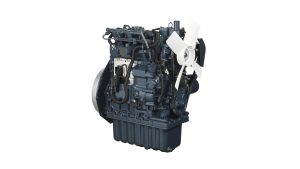
Kubota has responded to the diverse needs of construction and industrial equipment manufacturers throughout the world, including compliance with the latest emission regulations in each country, with the development of the D1105-K. This investment and commitment to innovation has earned the company the trust of many equipment manufacturers and end users of diesel engines under 100 horsepower for industrial use.
Building off the D902-K, Kubota developed the D1105-K engine as a power source complying with the latest European, American and Chinese emission regulations.
“Stricter emission regulations not only in Europe but the rest of the world are currently driving decarbonization demand,” said Tomokazu Matsushita, president of Kubota Engine America. “The electronic control of Kubota engines finely tune fuel injection to create better fuel efficiency than conventional mechanical engines, which reduces CO2 emissions and make exhaust gas cleaner. For these reasons, Kubota strives to broaden its electronically-controlled small engine lineup.”
The D1105-K engine consists of an 18.5kW (24.8HP) rated output, 3000 rpm, 3 cylinders and a 1.123L displacement. Also equipped with the TVCR combustion system, the D1105-K engine combines Kubota’s original combustion system with a unique electronic control technology developed specifically for small engines. The engine adopts the unique Kubota TVCR combustion system to realize both greater fuel efficiency and a compact size that makes it easy to use as a replacement to conventional Kubota engines. The D1105-K also utilizes a large oil pan, extending the period between essential regular oil changes up to 500 hours dependent on operating conditions. Overall, this provides better serviceability to reduce the time required for engine maintenance.
In addition to complying with emission regulations worldwide, the D1105-K complies with China’s national smoke regulations, Category Ⅲ. The new TVCR combustion method reduces black smoke to an invisible level. Moreover, manufacturers can directly mount the ECU to the engine to reduce the burden on the machine design when swapping out the engine, which is expected to reduce the length of development.
Manufacturers can easily replace conventional mechanical engines with the D1105-K because specifications, such as the exterior dimensions as well as the position of the intake and exhaust and power take-off, stay the same. It can also reduce the extra labor placed on the design of the main machine generally necessary to install an engine with an electronic control unit, such as designing the installation position and harnesses, because the ECU is mounted directly to the engine.
Additionally, The Controller Area Network (CAN) allows microcontrollers and devices to communicate with one another without a host computer. The electronic control enables use of the CAN communication protocol, which can control engine rotation and torque through signals sent from the vehicles. The CAN also enables the collection of the engine drive data necessary for telematics technology. This data improves drivability and operational efficiency by aggregating the torque characteristics that mechanical control cannot realize to reduce rotation speed under sudden load.
Kubota will contribute to realizing a carbon-neutral society by bolstering its lineup of not only electronically-controlled large engines already underway but also electronically-controlled small diesel engines.
Learn more about the D1105-K engine here.
